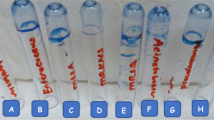Abstract
Boron (B) compounds are used in many fields ranging from medicine to industry. In this study, boric acid (BA) and disodium octaborate tetrahydrate (DOT) were evaluated for their antibacterial effects and antibiofilm capacities on selected strains of clinical and type cultures that are of veterinary concern (Staphylococcus aureus ATCC 25923, Aeromonas hydrophila ATCC 19570, Pseudomonas aeruginosa ATCC 27853, Brucella melitensis Rev1 and field isolates of Vibrio anguillarum, Aeromonas hydrophila, Yersinia ruckeri, Pseudomonas aeruginosa, Lactococcus garvieae, and Brucella abortus). Also, the inhibition of biofilm was monitored by scanning electron microscopy. The lowest MIC values of BA and DOT were measured, by broth method using microdilution, from Pseudomonas aeruginosa ATCC 27853, and were 0.385 and 0.644 mg/ml, respectively. Staphylococcus aureus was the most resistant to both BA and DOT. Using the microplate method, we observed that the strongest positivities for biofilm production were presented by Pseudomonas aeruginosa ATCC 27853 and also a clinical isolate of Lactococcus garviea. Lower values in the MIC scores for both B compounds were tested by measuring the inhibitory effect on biofilm production. We found that all the bacterial strains inhibited biofilm formation with the exception of the Pseudomonas aeruginosa strains for BA only and an isolate of Lactococcus garviea for DOT only. Such effects by BA and DOT are worth discussing in order to find novel approaches for different functions in medicine and industry using the bacteria tested.

Similar content being viewed by others
References
Kabu M, Akosman S (2013) Biological effects of boron. In: Whitacre DM (ed) Reviews of environmental contamination and toxicology. Springer, New York, pp. 57–75
Korkmaz M, Yenigün M, Bakırdere S, Ataman OY, Keskin S, Müezzinoğlu T, Lekili M (2011) Effects of chronic boron exposure on semen profile. Biol Trace Elem Res 143:738–750
Bolanos L, Lukaszewski K, Bonilla I, Blevins D (2004) Why boron? Plant Physiol Biochem 42:907–912
Kabu M, Uyarlar C, Zarczynska K, Milewska W, Sobiech P (2015) The role of boron in animal health. J Elem 20:535–541
Kabu M, Tosun M, Elitok B, Akosman MS (2015) Histological evaluation of the effects of borax obtained from different sources in different rat organs. Int J Morphol 33:255–261
Baker J, Ding ZC, Zhang YK, Hernandez V, Xia Y (2009) Therapeutic potential of boron-containing compounds. Future Med Chem 17:1275–1288
Hernandez V, Crepin T, Palencia A, et all (2013) Discovery of a novel class of boron-based antibacterials with activity against Gram-negative bacteria. Antimicrob Agents Ch 57:1394–1403
Mansour TS, Bradford PA, Venkatesan AM (2008) Recent developments in β-lactamases and inhibitors. Ann Rep Med Chem 43:247–267
Mah TF, O’Toole GA (2001) Mechanisms of biofilm resistance to antimicrobial agents. Trends Microbiol 9:34–39
Yılmaz MT (2012) Minimum inhibitory and minimum bactericidal concentrations of boron compounds against several bacterial strains. Turk J Med Sci 42:1423–1429
Shin K, Yun Y, Yi S, et all (2013) Biofilm-forming ability of Staphylococcus aureus strains isolated from human skin. J Dematol Sci 71:130–137
Roberts AP, Mullany P (2010) Oral biofilms: a reservoir of transferable, bacterial, antimicrobial resistance. Expert Rev Anti-Infect Ther 8:1441–1450
Clinical and Laboratory Standards Institute (CLSI) (2015) Methods for dilution antimicrobial susceptibility tests for bacteria that grow aerobically; approved standard—10th edn. Wayne, PA, USA
Stepanovic S, Vukovic D, Hola V, et all (2007) Quantification of biofilm in microtiter plates: overview of testing conditions and practical recommendations for assessment of biofilm production by Staphylococci. Acta Pathol Mic Sc 115:891–899
Li NJ, Li SQ, Jin HY (2003) Identification of bacterial biofilm by silver staining. Liaoning Pharm Clin Remedies 6:37–38
Meers PD, Chow CK (1990) Bacteriostatic and bactericidal actions of boric acid against bacteria and fungi commonly found in urine. J Clin Pathol 43:484–487
Caroline P, Campbell R (1990) Strategies of microbial cell survival in contact lens cases. Contact Lens Forum 15:27–36
Alma MH, Acemioglu B (2001) Boron resources, uses and forest products industry of Turkey’s. J Sc Eng 4:62–72
Howe PD (1998) A review of boron effects in the environment. Biol Trace Elem Res 66:153–166
Lakkis C, Fleiszig SM (2001) Resistance of Pseudomonas aeruginosa isolates to hydrogel contact lens disinfection correlates with cytotoxic activity. J Clin Microbiol 39:1477–1486
Nielsen FH (2014) Update on human health effects of boron. J Trace Elem Med Bio 28:383–387
De Seta F, Schmidt M, Vu B, Essmann M, Larsen B (2009) Antifungal mechanisms supporting boric acid therapy of Candida vaginitis. J Antimicrob Chemoth 63:325–336
Gordon S, Flynn D (2012) Compositions and methods for treating vaginal infections and pathogenic vaginal biofilms. Patent Publication No: EP 2529723 A2 www.google.com/patents/EP2529723A2?cl=en. Accessed 10 September 2015
Prutting SM, Cerveny JD (1998) Boric acid vaginal suppositories: a brief review. Int J Gynecol Obstet 6:191–194
Austin B (2011) Taxonomy of bacterial fish pathogens. Vet Res 42:1–20
Author information
Authors and Affiliations
Corresponding author
Ethics declarations
Conflict of Interest
The authors declare that they have no competing interests.
Rights and permissions
About this article
Cite this article
Sayin, Z., Ucan, U.S. & Sakmanoglu, A. Antibacterial and Antibiofilm Effects of Boron on Different Bacteria. Biol Trace Elem Res 173, 241–246 (2016). https://doi.org/10.1007/s12011-016-0637-z
Received:
Accepted:
Published:
Issue Date:
DOI: https://doi.org/10.1007/s12011-016-0637-z




